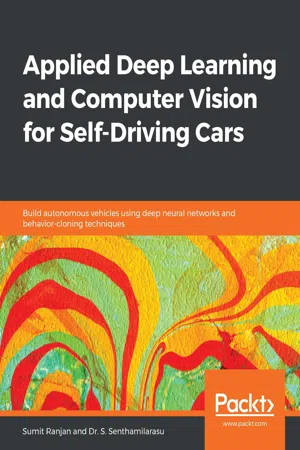
Applied Deep Learning and Computer Vision for Self-Driving Cars
Build autonomous vehicles using deep neural networks and behavior-cloning techniques
Sumit Ranjan, Dr. S. Senthamilarasu
- 332 pagine
- English
- ePUB (disponibile sull'app)
- Disponibile su iOS e Android
Applied Deep Learning and Computer Vision for Self-Driving Cars
Build autonomous vehicles using deep neural networks and behavior-cloning techniques
Sumit Ranjan, Dr. S. Senthamilarasu
Informazioni sul libro
Explore self-driving car technology using deep learning and artificial intelligence techniques and libraries such as TensorFlow, Keras, and OpenCV
Key Features
- Build and train powerful neural network models to build an autonomous car
- Implement computer vision, deep learning, and AI techniques to create automotive algorithms
- Overcome the challenges faced while automating different aspects of driving using modern Python libraries and architectures
Book Description
Thanks to a number of recent breakthroughs, self-driving car technology is now an emerging subject in the field of artificial intelligence and has shifted data scientists' focus to building autonomous cars that will transform the automotive industry. This book is a comprehensive guide to use deep learning and computer vision techniques to develop autonomous cars.
Starting with the basics of self-driving cars (SDCs), this book will take you through the deep neural network techniques required to get up and running with building your autonomous vehicle. Once you are comfortable with the basics, you'll delve into advanced computer vision techniques and learn how to use deep learning methods to perform a variety of computer vision tasks such as finding lane lines, improving image classification, and so on. You will explore the basic structure and working of a semantic segmentation model and get to grips with detecting cars using semantic segmentation. The book also covers advanced applications such as behavior-cloning and vehicle detection using OpenCV, transfer learning, and deep learning methodologies to train SDCs to mimic human driving.
By the end of this book, you'll have learned how to implement a variety of neural networks to develop your own autonomous vehicle using modern Python libraries.
What you will learn
- Implement deep neural network from scratch using the Keras library
- Understand the importance of deep learning in self-driving cars
- Get to grips with feature extraction techniques in image processing using the OpenCV library
- Design a software pipeline that detects lane lines in videos
- Implement a convolutional neural network (CNN) image classifier for traffic signal signs
- Train and test neural networks for behavioral-cloning by driving a car in a virtual simulator
- Discover various state-of-the-art semantic segmentation and object detection architectures
Who this book is for
If you are a deep learning engineer, AI researcher, or anyone looking to implement deep learning and computer vision techniques to build self-driving blueprint solutions, this book is for you. Anyone who wants to learn how various automotive-related algorithms are built, will also find this book useful. Python programming experience, along with a basic understanding of deep learning, is necessary to get the most of this book.
Domande frequenti
Informazioni
- Chapter 1, The Foundation of Self-Driving Cars
- Chapter 2, Deep Dive into Deep Neural Networks
- Chapter 3, Implementing a Deep Learning Model Using Keras
- Introduction to SDCs
- Advancement in SDCs
- Levels of autonomy
- Deep learning and computer vision approaches for SDCs
Introduction to SDCs

- The robotics approach
- The deep learning approach
Indice dei contenuti
- Title Page
- Copyright and Credits
- About Packt
- Contributors
- Preface
- Section 1: Deep Learning Foundation and SDC Basics
- The Foundation of Self-Driving Cars
- Dive Deep into Deep Neural Networks
- Implementing a Deep Learning Model Using Keras
- Section 2: Deep Learning and Computer Vision Techniques for SDC
- Computer Vision for Self-Driving Cars
- Finding Road Markings Using OpenCV
- Improving the Image Classifier with CNN
- Road Sign Detection Using Deep Learning
- Section 3: Semantic Segmentation for Self-Driving Cars
- The Principles and Foundations of Semantic Segmentation
- Implementing Semantic Segmentation
- Section 4: Advanced Implementations
- Behavioral Cloning Using Deep Learning
- Vehicle Detection Using OpenCV and Deep Learning
- Next Steps
- Other Books You May Enjoy